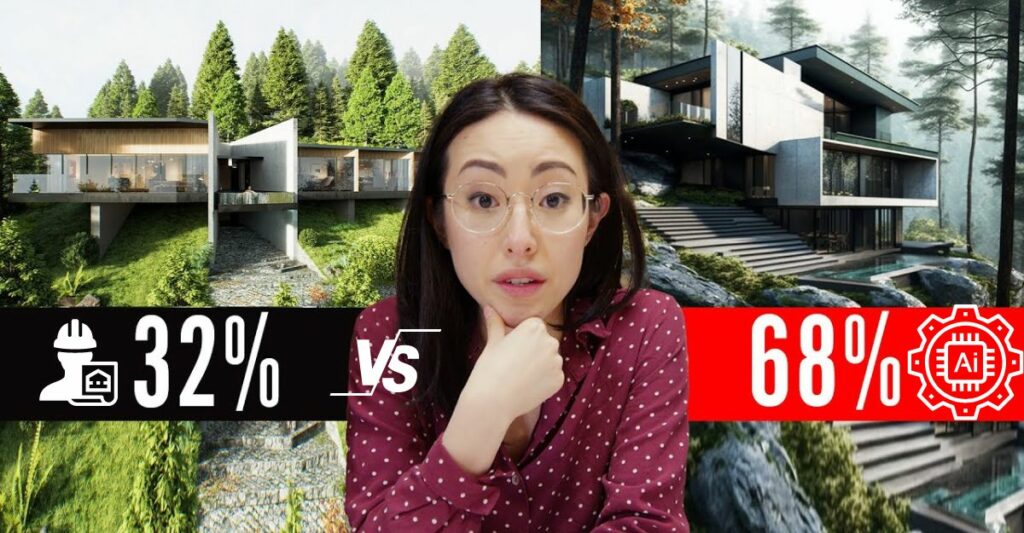Introduction
Join DamiLee, a licensed Architect and YouTuber based in Vancouver, BC, as she delves into a fascinating contest between AI and architects. With a passion for architecture, design, and the essence of creativity, DamiLee offers insights and shares innovative tools and strategies. Her aim is to empower young architects to pursue careers that are not only successful but deeply satisfying and impactful in the world of design.
We Tried to Compete with AI… [Architect AI Comparison]
Architect AI Comparison: Who Can Better Complete Architectural Design Work?
In a groundbreaking design competition, architects and AIs battle it out in a series of challenges to design a house. The AI team, leveraging advanced rendering software and the powerful HP Z8 Fury G5 workstation, outperforms human architects in all challenges, raising questions about the future of the design industry. The video explores the potential of AI in design, its limitations, and the importance of integrating AI tools with human creativity to navigate the evolving landscape of architecture and design.

Q&A

What is the main purpose of the design competition?
The main purpose of the design competition is to determine who is better at design skills, rendering skills, and describing their work: architects or AIs.
What are the requirements for the house design in the competition?
The house must be designed for a 280 square meter area on a sloped terrain with a 20-degree angle, include three bedrooms, a pool, and take advantage of the view overlooking the hill.
How many different design options did the AI team develop?
The AI team developed three different design options: The Cantilevered, The Fan, and The Cascade.
What is the significance of the pool in the design?
The pool is considered the ‘money shot’ of the design, as it is a focal point that enhances the entry experience and provides a key view from the top of the house.
Which rendering software did the team decide to use for its visualization process?
The team decided to use D5 for its visualization process due to its high-quality models, real-time changes, and ability to render complex scenes easily.
What was the outcome of the competition?
The AIs won all three challenges: the plan challenge, the render challenge, and the text challenge.
How does the speaker suggest architects and designers should approach AI?
The speaker suggests that architects and designers should not be afraid of AI but should try to use it to their advantage by integrating their existing skills with AI to create a new category for themselves.
What is the speaker’s view on the role of AI in the creative process of architecture?
The speaker believes that AI can’t replace architects because it can’t take abstract constraints and turn them into functional, conceptual, and feasible designs. It also can’t coordinate work, take liability, or make clients feel safe about their investments.

Complete content
In an invigorating delve into the competitive realm of design, a unique contest was staged to settle once and for all the superior between human architects and Artificial Intelligence (AI). This intensive showdown encompassed tests of design acumen, rendering capabilities, and the ability to articulate project descriptions. Archibeans, a Discord server community, played the impartial judges to determine the victor.
The challenge was to design a 280 square meter residence poised on a sloping terrain. Requirements included crafting a house with three bedrooms, a pool, and optimally positioned to relish the scenic hillside view.
The human team, powered by HP Z8 Fury G5 workstations with robust specs, capitalizing on the strategy of parallel development of distinct ideas that would translate into compelling render forms for subsequent challenges. Three intriguing options emerged:
The Cantilevered: This design proposed a bottom layer of bedrooms and an upper stratum of communal spaces, both volumes extending over the slope, interconnected by a double-storey atrium.
The Fan: True to its name, it spanned the site width like a fan, providing panoramic hill views, single-level living spaces, and bedrooms oriented sunward, with a central pool.
The Cascade: Conforming to the landscape contours, this design allotted unique vistas to each volume and featured interconnected interior spaces along with direct exterior bedroom access and an adjacent pool.
The second challenge required the teams to morph these ground plans into compelling conceptual renderings, reflecting the site’s distinctiveness. A meticulous selection of materials, landscaping, and environmental adjustments enhanced the visual storytelling in the renderings, underlining the structure’s integration with its surroundings.
The final obstacle tasked participants with composing a concise 150-word narrative that encapsulated their project’s essence. Despite the pressing deadline and the potential for technical hiccups, the human team’s efficiency was bolstered by the HP Z8 G5’s capacity for multitasking and reliability.
Surprisingly, the AI emerged victorious in all three categories. While the AI produced aesthetically pleasing images and descriptions, a closer inspection by the human team revealed functional oversights in the AI-generated plans. Concerns arose regarding the prospect of AI supplanting human jobs, particularly in design and architecture, with narrow AI (ANI) specializing in particular tasks, gaining proficiency exponentially each year.
The discourse shifted towards the ramifications of AI in shaping the next cadre of architects. The fear highlighted was that reliance on AI might bypass fundamental steps in architectural design, a process intrinsically iterative and responsive to tangible constraints. The AI’s production of seemingly final images and answers was contrasted with the non-linear, exploratory nature of architecture that aspires to encompass human needs and improve lives.
In the aftermath, a proactive approach towards AI is urged—leveraging its capabilities while innovatively integrating it with human skills, creating a new professional domain. The human team, undeterred, continues to exploit AI for tasks like research and visualization within their practice.
The video concludes with reflecting on the potential of AI in the architectural domain, stirring a conversation on whether AI could ever fully replace human architects and the contours of a future dominated by AI-driven design.





